
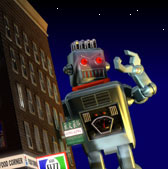

You may have seen Ray Harryhausen credited with Technical Effects (meaning special effects) for his amazing stop-motion animation in movies like Mighty Joe Young, It Came From Beneath The Sea, and The Beast From 20,000 Fathoms. Well, this column isn't really about special effects, just technical game details and behind-the-scenes programming stuff that we thought you might find interesting. We'll be updating it regularly, or whenever Lars thinks of something.
02/08/03: VITAL SIGNS
YOUR MONSTER'S MANY MOODS
Monster maintainance is an important part of the game: not just health, but also its food intake and anger levels. Failing to monitor and manage this will cause you to lose control of your monster as it goes berzerk, or into a feeding frenzy. This can be a dangerous situation - when your monster is out of control, it ignores your commands and pays no attention to threats or hazards around it. It can then be easily lured by bait, or walk into traps set by the humans.
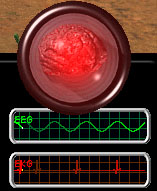
mood and health indicators
The left side of the interface contains indicators that tell you how your monster is feeling at any given moment. At top left is the brain ball, which gives you insight into your monster's mind, animating in response to its moods and thoughts:
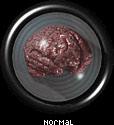

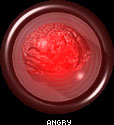
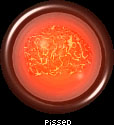
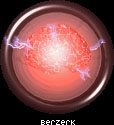
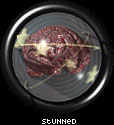
Below the brain ball is an EEG (electro-encephalogram) graph showing the monster's brainwaves, which mostly reflect the monster's level of agitation or serenity. If these get too high, your monster will go throw a tantrum and smash stuff at random until his temper is back under control. Some monsters (mainly the less intelligent ones) are more prone to throw tantrums than others. The EEG also shows when your monster is momentarily stunned by a heavy hit.
Below the EEG is an EKG (electro-cardiogram), which monitors the monster's heartbeat. It beats faster as your monster exerts itself, which in turn results in a higher rate of energy/food consumption. Overexert your monster, and it will need to take a forced rest. Get too hungry, and your monster will lose control trying to eat anything that moves. Again, a dangerous situation. Additionally, the EKG shows your monster's health in how regular and strong the heartbeat is. A gravely wounded monster's heartbeat is noticeably weak and irregular.
IN A HEARTBEAT
The heartbeats and brainwaves are customized for the basic monster type. Vertebrate monsters like the giant newt and giant woman have at least a 2-chamber heart and the recognizable QRS waveform. Insects, like the giant mantis and giant ant, have a series of heart-like chambers which pump blood in a peristaltic manner, so the heartbeat is shown as a quick series of pulses. The spider, with a single-chamber heart, has a single pulse. For inorganic monsters, like the robot and UFO, the EKG & EEG displays will change to show relevant data for them, such as reactor core temperature and CPU clock. Of course, it's not all scientifically accurate: what does the heartbeat of a giant killer plant look like, after all? For him, I opted for a regular positive sinusoid pulse representing TACT (transpiration, adhesion, cohesion and tension) within the xylem, and tropism (the means by which plants can move).
PREVIOUS ARTICLES:
- 01/01/03: BUILDING COLLAPSE SEQUENCES
- 12/01/02: BOX LISTS
- 10/28/02: HAZARD MAP
- 10/18/02: TERRAIN TILES
- 10/06/02: BUILDING TRANSPARENCY
- 9/25/02: WIND MAPPING
 | © 2004 Octopus Motor They Came From Hollywood is a registered trademark of Octopus Motor |  |